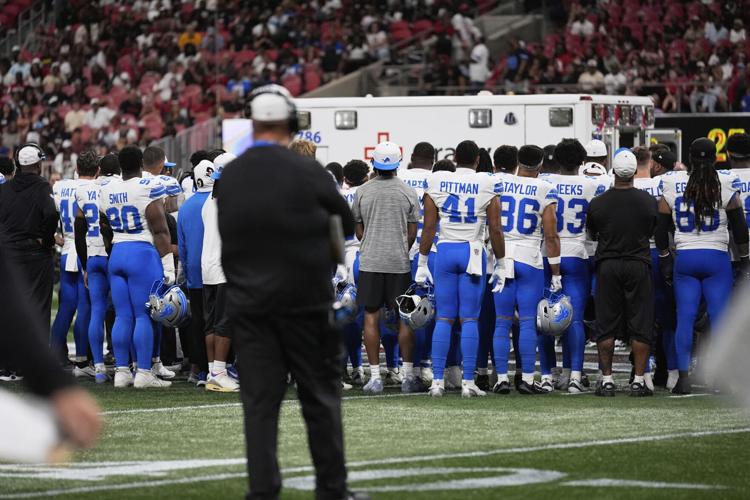The Injury Suffered by Detroit Lions Safety Morice Norris: A Wake-Up Call for Professional Sports
On a fateful Friday, Detroit Lions safety Morice Norris experienced a traumatic injury during practice that sent shockwaves through the NFL community and fans alike. The incident was a stark reminder of the inherent dangers faced by professional athletes, especially in high-impact sports such as football. Norris’s injury, which appeared severe and potentially career-altering, brought renewed focus to the physical toll that professional sports exacts on players.
While sports injuries are an unfortunate reality, they also serve as catalysts for innovation, better safety practices, and improved protocols designed to protect athletes. This article aims to analyze the injury incident involving Norris, examine the broader context of sports injuries in professional football, and explore emerging strategies, technologies, and policy changes that can help reduce the risk of injury to athletes at all levels.
Details surrounding Norris’s injury remain sensitive and under investigation, but reports indicate that during a routine practice drill, Norris sustained a significant blow to the helmet and torso. Eyewitnesses described the hit as “brutal,” with Norris collapsing on the field, clutching his leg or torso, and teammates immediately signaling for medical assistance.
Initial assessments suggested a potential ligament tear, broken bones, or spinal injury. Emergency medical personnel responded swiftly, and Norris was transported to a nearby hospital for further evaluation. The injury was serious enough to sideline him indefinitely, raising concerns about his recovery prospects and long-term health.
Norris’s injury exemplifies the brutal nature of football, where rapid, high-impact collisions are commonplace, and even with protective gear, players remain vulnerable to catastrophic injuries.
Professional sports, especially contact sports like football, basketball, hockey, and rugby, inherently involve physical risks. Athletes push their bodies to the limit, often subjecting themselves to repeated impacts, stress fractures, and joint wear-and-tear. Over time, these forces accumulate, leading to chronic injuries such as arthritis, concussions, and musculoskeletal disorders.
One of the most pressing concerns in football is traumatic brain injury (TBI), including concussions. Advances in neuroimaging and research have shown that repeated blows to the head can cause long-term cognitive decline, depression, and neurodegenerative diseases like Chronic Traumatic Encephalopathy (CTE). The NFL has taken steps to improve concussion protocols, but the risk remains significant.
Spinal injuries, like the one Norris potentially suffered, can result in paralysis or even death. Such injuries often occur during tackles or collisions where the spinal column is compressed or violently twisted. Despite protective gear, the force involved in these impacts can be devastating.
Ligament tears (ACL, MCL), broken bones, dislocated joints, and muscle strains are common among professional athletes. Repetitive impacts and sudden movements put enormous strain on the body, sometimes resulting in career-threatening injuries.
Beyond physical injuries, athletes often experience psychological trauma, including anxiety, depression, and identity crises following severe injuries or career setbacks. The mental health aspect of sports injuries is increasingly recognized as a critical component of athlete care.
Injuries like Norris’s can have immediate consequences — sidelining players, affecting team performance, and sometimes leading to retirement. Long-term, many athletes face chronic pain, reduced mobility, and diminished quality of life.
Severe injuries can derail promising careers, lead to loss of income, and impose hefty medical bills. For some athletes, injuries end their playing days prematurely, forcing them into new careers or long-term health management.
High-profile injuries highlight the risks of professional sports, influencing public perception, youth participation, and sports regulation policies.
While some injuries are unavoidable due to the nature of contact sports, a combination of technological innovations, training protocols, rule changes, and policy reforms can significantly mitigate risks.
**Helmet Technology:** Modern helmets incorporate advanced materials like carbon fiber composites, impact-absorbing liners, and sensor technology to detect dangerous impacts. Companies are investing in helmet designs that better dissipate collision forces and reduce concussive injuries.
**Body Armor and Padding:** Innovations in shoulder pads, rib protectors, and thigh guards aim to reduce the impact transmitted during collisions. Smart padding, which can adjust firmness based on impact, is emerging.
**Wearable Impact Sensors:** Devices embedded in gear monitor real-time forces experienced by athletes, allowing coaches and medical staff to make informed decisions about player safety during and after impacts.
**Proper Tackling Techniques:** Teaching athletes to tackle with proper form—such as head-up tackling rather than head-first—reduces the risk of head and neck injuries.
**Strengthening and Conditioning:** Targeted exercises improve muscular support around joints and the neck, providing better protection during impacts.
**Neuromuscular Training:** Programs that enhance proprioception and balance help athletes respond better to unpredictable impacts.
**Protective Rule Amendments:** The NFL and other leagues have introduced rules to limit dangerous plays, such as targeting and helmet-to-helmet hits.
**Strict Penalties:** Enforcing penalties for illegal or dangerous plays discourages reckless behavior on the field.
**Game Time Adjustments:** Modifying game rules—like reducing the number of contact drills during practice or limiting full-contact sessions—can lower injury risk.
**Concussion Protocols:** Strict assessment procedures, including sideline tests and neurocognitive evaluations, ensure players don’t return prematurely.
**Injury Surveillance:** Data collection and analysis help identify injury patterns and inform preventative strategies.
**Rehabilitation and Return-to-Play Guidelines:** Evidence-based protocols ensure athletes recover fully before resuming play, reducing re-injury risk.
**Motion Capture and Biomechanical Analysis:** Using high-speed cameras and sensors, teams can analyze players’ movements to identify risky techniques or biomechanics.
**AI and Machine Learning:** Predictive models can flag players at higher injury risk based on workload, fatigue levels, and impact history.
**Virtual Reality (VR) Training:** VR simulations allow players to practice decision-making and tackling techniques safely, reducing injury during actual gameplay.
**Player Education:** Regular seminars on injury prevention, proper techniques, and the importance of reporting symptoms foster a safety-first culture.
**Coaching Accountability:** Coaches are trained to prioritize player health over aggressive tactics that may increase injury risk.
**Youth Development:** Instilling safety awareness early in youth sports helps develop habits that reduce injury risks at all levels.
Leagues like the NFL, NCAA, and international bodies are increasingly adopting policies aimed at injury prevention. These include stricter helmet standards, limiting full-contact practices, and enhancing medical staff presence during games and practices.
Investments in sports medicine research, biomechanics, and injury prevention technologies are crucial. Public and private funding supports innovation and evidence-based policy development.
Players are advocating for better health protections, transparency about injury risks, and long-term care support. Collective bargaining agreements now include clauses related to injury management and post-care.
As sensors and wearable tech become more advanced and affordable, their integration into standard practice will allow real-time injury risk assessment and personalized safety protocols.
Materials science breakthroughs will lead to lighter, stronger, and more impact-absorbing gear, dramatically improving player protection.
Artificial intelligence and big data analytics will refine injury prediction models, enabling proactive rather than reactive safety measures.
A shift toward holistic health management—covering physical, mental, and emotional well-being—will optimize athlete longevity and safety.
Fostering a culture where player safety is prioritized over aggressive play is essential. This involves education, leadership, and redefining success metrics within the sport.
The injury suffered by Morice Norris serves as a sobering reminder of the risks inherent in professional sports. While the physical nature of football will always carry some danger, ongoing advancements in equipment, training, policy, and technology hold promise for making the game safer.
Sports organizations, medical researchers, coaches, and players must collaborate to continuously improve safety standards. Embracing innovation and fostering a culture that prioritizes health can help reduce injuries, protect athletes, and ensure that the thrill of the game does not come at an unacceptable cost.
In honoring athletes like Norris, the sports community must commit to learning from tragedies, investing in safety, and working toward a future where competition is fierce but safety is paramount.
Sports have always been a reflection of human resilience, determination, and passion. Ensuring that athletes can pursue their dreams while minimizing the risks they face is a shared responsibility. As technology advances and policies evolve, there’s hope that the next generation of athletes will face fewer injuries and enjoy longer, healthier careers—turning moments of tragedy into catalysts for meaningful progress.



